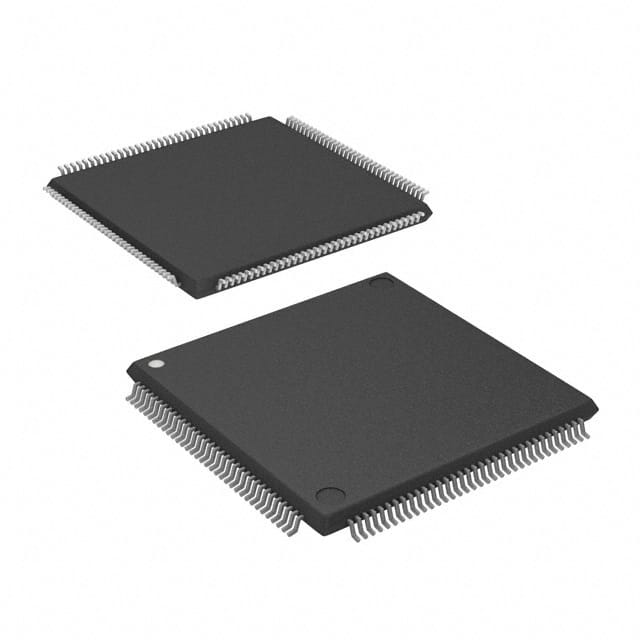EP1C3T144A8N
Product Overview
- Category: Programmable Logic Device (PLD)
- Use: EP1C3T144A8N is a PLD that can be programmed to perform various logic functions.
- Characteristics: It offers high performance, low power consumption, and flexibility in designing digital circuits.
- Package: The EP1C3T144A8N comes in a 144-pin Thin Quad Flat Pack (TQFP) package.
- Essence: This PLD allows users to implement complex digital circuits using programmable logic.
Specifications
- Logic Elements: EP1C3T144A8N has 3,000 logic elements.
- Embedded Memory: It includes 36 kilobits of embedded memory.
- I/O Pins: The device has 116 I/O pins.
- Clock Management: It features up to four phase-locked loops (PLLs) for clock management.
- Operating Voltage: The operating voltage range is 1.15V to 1.25V.
- Speed Grade: EP1C3T144A8N is available in different speed grades, such as -6, -7, and -8.
Pin Configuration
The EP1C3T144A8N has a detailed pin configuration as follows:

Functional Features
- Programmability: The EP1C3T144A8N can be programmed to implement various logic functions, allowing for flexible circuit design.
- High Performance: It offers fast operation speeds, making it suitable for applications requiring real-time processing.
- Low Power Consumption: The device is designed to minimize power consumption, making it energy-efficient.
- Versatility: EP1C3T144A8N can be used in a wide range of applications, including telecommunications, industrial automation, and consumer electronics.
Advantages and Disadvantages
Advantages: - Flexibility in circuit design - High performance - Low power consumption - Versatile application possibilities
Disadvantages: - Limited logic elements compared to higher-end PLDs - Higher cost compared to simpler logic devices
Working Principles
The EP1C3T144A8N operates based on the principles of programmable logic. It consists of configurable logic blocks (CLBs), interconnect resources, embedded memory, and I/O pins. The CLBs can be programmed to perform various logic functions, such as AND, OR, and XOR gates. The interconnect resources allow for routing signals between different CLBs and I/O pins. The embedded memory provides additional storage for data. By programming the device, users can define the desired logic functions and interconnections, enabling the implementation of complex digital circuits.
Application Field Plans
EP1C3T144A8N finds applications in various fields, including:
- Telecommunications: It can be used in network switches, routers, and communication equipment.
- Industrial Automation: The device is suitable for controlling and monitoring industrial processes.
- Consumer Electronics: EP1C3T144A8N can be utilized in gaming consoles, set-top boxes, and multimedia devices.
- Automotive: It can be employed in automotive control systems and infotainment systems.
- Medical Devices: The PLD can be integrated into medical equipment for signal processing and control.
Alternative Models
Here are some alternative models that offer similar functionality:
- Xilinx XC3S50AN-4TQG144C
- Altera EPM240T100C5N
- Lattice LC4032V-75TN48C
These models provide comparable programmable logic capabilities and can be considered as alternatives to EP1C3T144A8N.
In conclusion, the EP1C3T144A8N is a programmable logic device that offers flexibility, high performance, and low power consumption. It can be used in various applications across different industries. While it has some limitations in terms of logic elements and cost, alternative models are available to suit specific requirements.
기술 솔루션에 EP1C3T144A8N 적용과 관련된 10가지 일반적인 질문과 답변을 나열하세요.
Sure! Here are 10 common questions and answers related to the application of EP1C3T144A8N in technical solutions:
Q1: What is EP1C3T144A8N? A1: EP1C3T144A8N is a specific model number for a field-programmable gate array (FPGA) chip manufactured by Altera.
Q2: What is an FPGA? A2: FPGA stands for Field-Programmable Gate Array. It is an integrated circuit that can be programmed after manufacturing to perform various digital logic functions.
Q3: What are the key features of EP1C3T144A8N? A3: Some key features of EP1C3T144A8N include 3,000 logic elements, 144-pin TQFP package, and support for various I/O standards.
Q4: What are the typical applications of EP1C3T144A8N? A4: EP1C3T144A8N can be used in a wide range of applications such as industrial automation, telecommunications, automotive systems, and embedded computing.
Q5: How do I program EP1C3T144A8N? A5: EP1C3T144A8N can be programmed using hardware description languages (HDLs) like VHDL or Verilog, along with specialized software tools provided by Altera.
Q6: Can EP1C3T144A8N be reprogrammed? A6: Yes, EP1C3T144A8N is a reprogrammable FPGA, which means you can change its functionality by reprogramming it multiple times.
Q7: What are the power requirements for EP1C3T144A8N? A7: EP1C3T144A8N typically operates at a voltage range of 3.0V to 3.6V and requires a stable power supply with appropriate current capabilities.
Q8: Can EP1C3T144A8N interface with other components or devices? A8: Yes, EP1C3T144A8N supports various I/O standards and can interface with other components or devices such as sensors, memory modules, and communication interfaces.
Q9: Are there any development boards available for EP1C3T144A8N? A9: Yes, Altera provides development boards specifically designed for EP1C3T144A8N, which include necessary connectors, peripherals, and programming interfaces.
Q10: Where can I find technical documentation and support for EP1C3T144A8N? A10: You can find technical documentation, datasheets, application notes, and support resources for EP1C3T144A8N on the official website of Altera or its parent company Intel.
Please note that the specific details and answers may vary depending on the manufacturer's documentation and product specifications.


